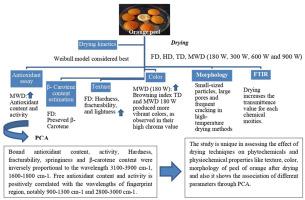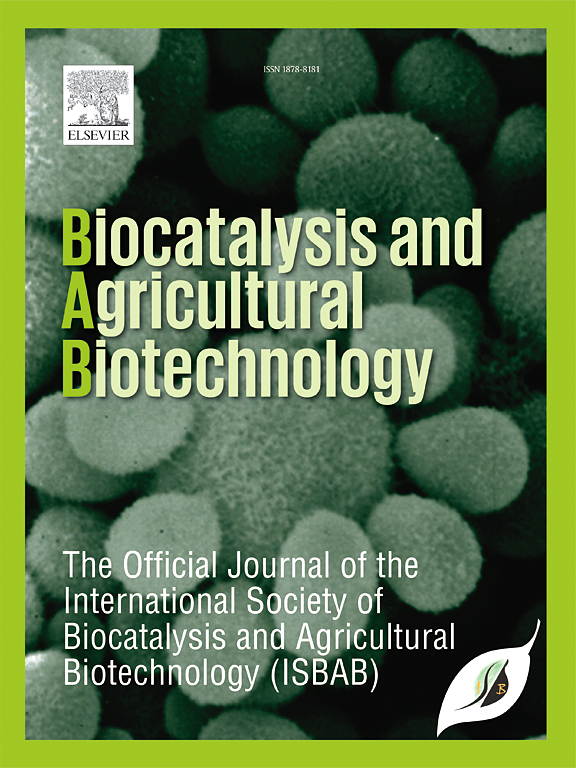Analysis of the influence of different drying processes on the quality attributes of orange peel
IF 3.8
Q2 BIOTECHNOLOGY & APPLIED MICROBIOLOGY
引用次数: 0
Abstract
The present research aimed to assess the effect of different drying processes on kinetics, antioxidant content and activity, texture, colour, morphology, and β-carotene content of orange peel (OP). The utilization of microwave drying resulted in a notable increase in the rate of evaporation of water present in the orange peel. This process facilitated the release of bound polyphenols. The OP dried at 600 W exhibited the highest total phenolic compound (24.65 mg GAE/g) and total flavonoid compound (11.73 mg QE/g), as observed in the recorded data. The total antioxidant value exhibited a decrease at both elevated and reduced levels of microwave power compared to raw OP. The study found that the drying model proposed by the Weibull model exhibited the most optimal fit, as evidenced by a low SSerror (1.6 × 10−3-16.12 × 10−3), RMSE (0.02–0.05) and high R2 (0.99–1.00). Among dried products, high hardness (30.92 ± 1.26 N), fracturability (28.31 ± 1.22 N), and lightness (74.01 ± 0.38) were observed in freeze-dried (FD) OP. The browning index was high in microwave drying at 180 W (MWD 180 W), and tray drying (TD) which also produced more vibrant colours, as observed in their high chroma value. The high performance liquid chromatography (HPLC) showed that the retention of β-carotene was observed highest in FD (0.057 ± 0.003 mg/g) and lowest in TD (0.032 ± 0.002 mg/g). The morphological study revealed small-sized particles in high-temperature drying methods (MWD 900 W and TD). Large pores and frequent cracking were observed in microwave drying compared to FD. Four clusters are formed in Principal component analysis (PCA) loading of Fourier transform infrared (FTIR) spectra based on their similar characteristics as found in FTIR. Antioxidant content and texture are closely related to the chemical moieties, as observed in PCA.

分析不同干燥工艺对橙皮质量属性的影响
本研究旨在评估不同干燥工艺对橘子皮(OP)的动力学、抗氧化剂含量和活性、质地、颜色、形态和β-胡萝卜素含量的影响。使用微波干燥显著提高了橘皮中水分的蒸发速度。这一过程促进了结合多酚的释放。从记录的数据中可以看出,在 600 W 下干燥的 OP 表现出最高的总酚类化合物(24.65 毫克 GAE/克)和总黄酮类化合物(11.73 毫克 QE/克)。与未加工的 OP 相比,在微波功率升高和降低的情况下,总抗氧化值都有所下降。研究发现,Weibull 模型提出的干燥模型具有最佳拟合效果,表现为较低的 SSerror(1.6 × 10-3-16.12 × 10-3)、RMSE(0.02-0.05)和较高的 R2(0.99-1.00)。在干制品中,冻干(FD)OP 的硬度(30.92 ± 1.26 N)、可碎性(28.31 ± 1.22 N)和轻度(74.01 ± 0.38)均较高。180 瓦微波干燥(MWD 180 W)和托盘干燥(TD)的褐变指数较高,从其高色度值可以看出,这两种干燥方法也能产生更鲜艳的颜色。高效液相色谱法(HPLC)显示,β-胡萝卜素的保留率在 FD 中最高(0.057 ± 0.003 mg/g),在 TD 中最低(0.032 ± 0.002 mg/g)。形态学研究显示,高温干燥法(MWD 900 W 和 TD)中的颗粒较小。与 FD 相比,在微波干燥中观察到了较大的孔隙和频繁的裂纹。根据傅立叶变换红外光谱(FTIR)中发现的相似特征,在傅立叶变换红外光谱的主成分分析(PCA)加载中形成了四个聚类。正如在 PCA 中观察到的那样,抗氧化剂含量和质地与化学分子密切相关。
本文章由计算机程序翻译,如有差异,请以英文原文为准。
求助全文
约1分钟内获得全文
求助全文
来源期刊

Biocatalysis and agricultural biotechnology
Agricultural and Biological Sciences-Agronomy and Crop Science
CiteScore
7.70
自引率
2.50%
发文量
308
审稿时长
48 days
期刊介绍:
Biocatalysis and Agricultural Biotechnology is the official journal of the International Society of Biocatalysis and Agricultural Biotechnology (ISBAB). The journal publishes high quality articles especially in the science and technology of biocatalysis, bioprocesses, agricultural biotechnology, biomedical biotechnology, and, if appropriate, from other related areas of biotechnology. The journal will publish peer-reviewed basic and applied research papers, authoritative reviews, and feature articles. The scope of the journal encompasses the research, industrial, and commercial aspects of biotechnology, including the areas of: biocatalysis; bioprocesses; food and agriculture; genetic engineering; molecular biology; healthcare and pharmaceuticals; biofuels; genomics; nanotechnology; environment and biodiversity; and bioremediation.
 求助内容:
求助内容: 应助结果提醒方式:
应助结果提醒方式:


